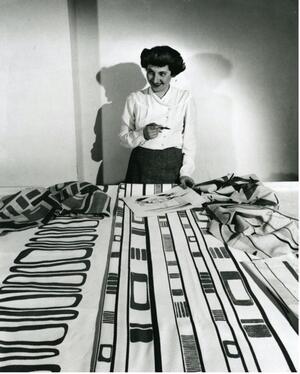Ruth Adler Schnee wins the Kresge Eminent Artist Award
On January 28, 2015, at the age of 91, Ruth Adler Schnee was honored with the prestigious Kresge Eminent Artist Award in recognition of her influential career as one of the founding figures of contemporary textile design in the United States. Known for her signature style of geometric designs and intensely saturated palettes, her enduring career has spanned almost three quarters of a century.
Ruth Adler Schnee was born on May 13, 1923, in Frankfurt am Main, Germany, and was surrounded by art from a young age. Adler Schnee’s mother, Marie Adler, a lover of color in her own right, studied calligraphy and bookbinding at the modernist German art school, the Bauhaus. Adler Schnee and her family persevered through Jewish persecution in Nazi Germany where her father, Joseph Adler, was detained and interned at the Dachau concentration camp. After some months, Adler Schnee’s mother was successful in getting her father released, and the family immediately fled Germany in March 1939, eventually settling in Detroit, Michigan. In a 2002 interview with her daughter, Adler Schnee discussed that when she was thirteen years old and living in 1936 Germany, retail shops were not allowed to trade with Jews. For this reason, many of her clothes were custom-made and designed by Adler Schnee herself from a young age.
Ruth Adler Schnee earned her high school degree in 1942 from Cass Technical High School in Detroit, Michigan, a well-known multi-disciplinary public school where she studied fashion design. She then received a full scholarship to the Rhode Island School of Design (RISD) to pursue fashion design. Early in her undergraduate career, she decided instead to study interior design and graduated in 1945. Pursuing her interest in modern architecture, Adler Schnee landed a job in New York in the spring of 1945 with Raymond Loewy, known as the "Father of Industrial Design." Here, she created enduring relationships with notable architects Warren Platner and Minoru Yamasaki. By the fall of 1945, she was enrolled in graduate school at the Cranbrook Academy of Art in Bloomfield Hills, Michigan, where, in 1946, she was one of the first women to graduate from Cranbrook with an MFA in design. Cranbrook introduced Adler Schnee to prominent Finnish architect Elilel Saarinen, Cranbrook’s first president, and Loja, Elilel’s wife, who was head of the academy’s weaving department. At the time in which Adler Schnee was beginning her career in architecture and design, the field was not open to women, Jewish women in particular, but that did not stop her.
Adler Schnee’s introduction to textile design came while working on her entry for the Chicago Tribune’s “Better Rooms for Better Living” residential design competition. She could not find draperies on the market that suited her modernist aesthetic and opted to design her own and draw them into her submission. After winning the competition, an architecture firm contacted Adler Schnee about purchasing the draperies. When the firm learned these draperies did not exist, they offered to commission Adler Schnee to fabricate her abstract-patterned shapes and bold colors as draperies for their new auto showrooms. In 1947, at the age of 24, Adler Schnee opened her own design studio and screen-printing workshop in Detroit, Michigan, Ruth Adler, Inc., in order to bring these draperies to life.
In 1947, Adler Schnee met Edward Schnee, a Yale economics major whom she married in 1948. Edward Schnee was an enthusiastic supporter of Adler Schnee’s work, and an integral part of running the business side of her design studio, which became Adler/Schnee Associates, a Detroit institution for avant-garde design. The shop’s retail department sold Adler Schnee’s own designs as well as curated modernist home décor pieces. Adler Schnee’s work continued to be critically received, winning the American Institute of Decorators Award in 1947 and 1948; the distinguished International Celanese Corporation Prize for Strata in 1950; and the Good Design Award, awarded by the curator of New York’s Museum of Modern Art in 1954. The Adler Schnee family grew throughout the 1950s with the birth of her children, Anita, Jeremy, and Daniel Schnee. Adler/Schnee Associates moved to the Harmonie Park area of downtown Detroit where it operated until its closure in 1976.
Adler Schnee’s proclivity for brightly-colored textile designs limited public reception because architects of the time were drawn to more neutral palettes. Support came later, as museum curators at the Art Institute of Chicago and the Montreal Museum of Decorative Arts discovered and promoted her work. The 1990s brought a successful 20-year flourishing collaboration between Adler Schnee and Texas-based contract upholstery company, Anzea, which won Adler Schnee the coveted Good Design Award from the Chicago Athenaeum Museum of Architecture and Design. While Adler Schnee is best known for her vibrant textile designs, her work as an interior architectural planner is equally well-regarded. Throughout her career, she designed interior spaces and furnishings for private and public clients, working with masters of modern architectural design, including Albert Kahn, Frank Lloyd Wright, Paul Rudolph, Eero Saarinen, Minoru Yamasaki, and Clifford Wright. Adler Schnee’s most significant commissions include the Ford Rotunda Auditorium in Dearborn, Michigan, the World Trade Center in New York, and the Feld-Weisberg Clinic in Detroit.
In 2012, at the age of 89, Adler Schnee entered into a 20-year contract with the contemporary design firm, KnollTextiles. Adler Schnee’s textiles can be found everywhere from museum collections to private homes and offices.
This entry was created for This Week in History as part of a course on the history of American Jews and Social Justice taught by Karla Goldman at the University of Michigan, Winter 2021.
Sources: https://www.architecturaldigest.com/story/ruth-adler-schnee-kresge-award; https://kresge.org/news-views/textile-artist-ruth-adler-schnee-selected-as-2015-kresge-eminent-artist/; https://www.knoll.com/knollnewsdetail/in-conversation-ruth-adler-schnee-2; https://www.metrotimes.com/detroit/how-the-world-finally-caught-up-with-mid-century-modern-design-pioneer-ruth-adler-schnee/Content?oid=23951129; https://www.aaa.si.edu/collections/interviews/oral-history-interview-ruth-adler-schnee-12111#transcript




I regret to report that Ruth died earlier this month (Jan. 2023) at age 99. Her life was a blessing and she will be missed.